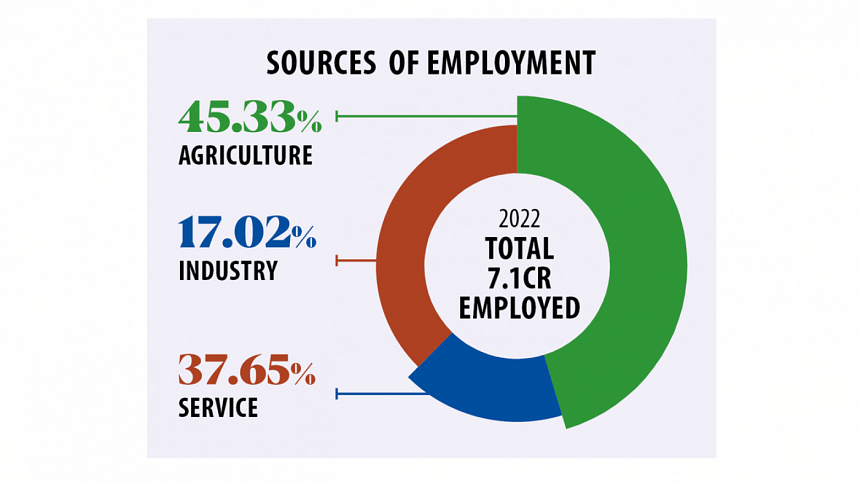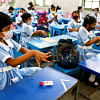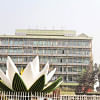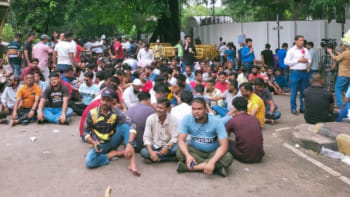Labour Force Survey 2022: Agriculture still main job generator

It seems the Bangladesh economy is stuck in a time warp, going by the latest edition of the Labour Force Survey unveiled yesterday.
As an economy develops, more and more labour move out of the agriculture sector and join the manufacturing sector. In the next stage of transformation, workers move out of manufacturing and on to the services sector.
In Bangladesh, agriculture continues to be the chief source of employment -- in 2022. In 2016-17, the sector accounted for 40.6 percent of employment. In 2022, that ratio increased to 45.33 percent -- indicating that the country continues to be a largely agrarian society.
The share of manufacturing in total employment declined from 20.4 percent in 2016-17 to 17.02 percent -- raising questions about the nature of economic development in recent years.
Over the past decade, the Bangladesh economy clocked in respectable GDP growth of about 6 percent on average, and just before the global coronavirus pandemic started, it was amongst the fastest growing nations in the world.
It is a similar story in the services sector: its share of employment declined to 37.65 percent from 39 percent in 2016-17, when the labour force survey was last carried out by the Bangladesh Bureau of Statistics.

"This is not a good sign," said Ahsan H Mansur, executive director of the Policy Research Institute of Bangladesh.
In 2022, the total number of employed in the manufacturing sector stands at 1.21 crore, down from 1.24 crore in 2016-17.
This is somewhat puzzling because industry, particularly manufacturing, was the fastest-growing sector during the same period, said Zahid Hussain, a former lead economist of the World Bank's Dhaka office.
"How can the absolute number employed decline when production in the sector is growing at nearly double-digit rates? Automation may be one explanation, but has it happened to an extent that would fully explain the decline in industrial employment?"
Skill shortage can explain slower employment growth, not decline in employment, Hussain said.
"When there is no employment option, you go back to farming. The strategy is you migrate from agriculture to industries or services, esp. industries. This shows that the manufacturing growth could not be maintained," said Mansur, also a former economist of the International Monetary Fund.
The total employed by the agriculture sector increased from 2.47 crore in 2016-17 to 3.22 crore in 2022.
"When more worker is employed in agriculture, the output per worker declines. When labour productivity is not increasing, it is alarming for economic growth," Mansur said, adding that insufficient investment could be the reason for the lack of industrial job creation.
Meanwhile, the total number of employed has increased from 6.08 crore to 7.08 crore in the six years.
"All of the increases in employment seem to have happened in agriculture and services where job quality is a major issue. The share of agriculture in GDP has been declining at a time when employment expanded by over 70 lakh. This fact deserves deeper analysis," Hussain said.
The total number of unemployed has declined from 27 lakh to 26.3 lakh. Subsequently, the unemployment rate has come down to 3.6 percent from 4.2 percent.
"These are nonsensical statistics. Our problem is underemployment as the poor have to work to survive in a country like Bangladesh," Mansur said.
The definition of unemployment is the one used by the International Labour Organisation.
"That definition applies to advanced economies. What is relevant is the unemployment among the educated. The unemployment there is 24-25 percent," said Mansur, also the chairman of Brac Bank.
However, the survey brought some good news: female labour force participation increased in the six years.
In 2016-17, 1.86 crore women were employed. That number increased to 2.5 crore in 2022.
"Labour force growth came entirely from a remarkable increase in female participation rate by over 6 percentage points," Hussain said.
In 2016-17, the female labour force participation rate was 36.3 percent, which increased to 42.68 percent in 2022.
"This is necessary. It is no longer possible to run a house on one income. This has positive socioeconomic implications," Mansur added.
Female labour force participation in urban areas declined significantly: from 31 percent in 2016-17 to 23.6 percent in 2022, Hussain said.
"There appears to have been a reverse migration of female labour from urban to rural areas," he said.
Off-farm activities have increased in recent times, said Planning Minister MA Mannan at the launch of the survey.
Activities that are related to crops and livestock but occur outside of the field such as processing, packaging and other forms of value addition are termed off-farm activities.
This perhaps explains the increase in female labour force participation in rural areas.
Female labour force participation rate in rural areas increased from 38.6 percent to 50.89 percent in 2022.
Mannan went on to cite a survey by the Bangladesh Institute of Development Studies that found the poverty rate declined from 20 percent to 16 percent during the pandemic to further his point.
"We did not go for a hard lockdown -- our roads were always open. We swiftly ensured a stimulus package. As a result, Bangladesh fared better than other countries with the pandemic," he added.
During the pandemic, many returned to villages and took up farming, said Shamsul Alam, the state minister of planning.
There has been a structural change in the agricultural sector, with a variety of crop options and plenty of incentives.
"So the jump in rural jobs is not unrealistic," he said.
In 2016-17, 4.39 crore people were employed in rural areas. In 2022, that number stood at 5.31 crore.
In contrast, urban employment increased from 1.69 crore to 1.77 crore in 2022.
Alam, however, called for increasing blue-collar jobs.
Garment factories account for up to 80 percent of manufacturing jobs and employment generation in those plants is stagnating.
"Manufacturing jobs must increase but that can't happen overnight," he added.
BBS is considering publishing the labour force survey, which was first done in 1980, every quarter, said Shahnaz Arefin, secretary of the statistics and informatics division.

 For all latest news, follow The Daily Star's Google News channel.
For all latest news, follow The Daily Star's Google News channel. 








Comments